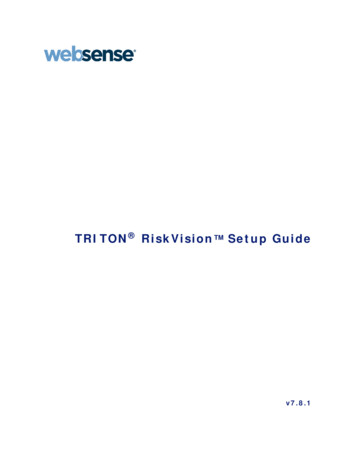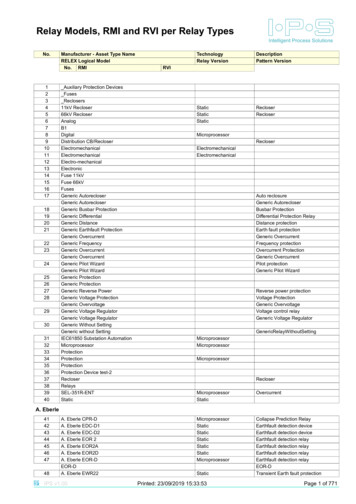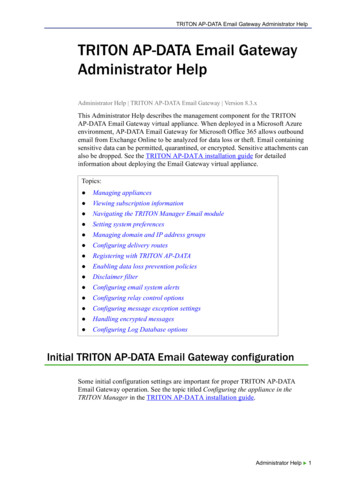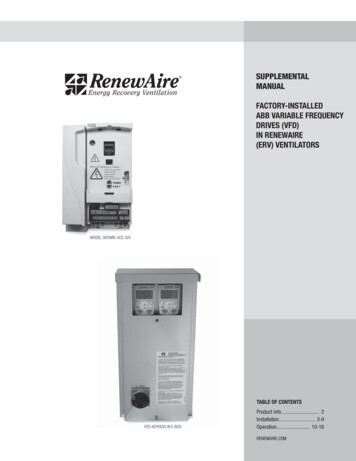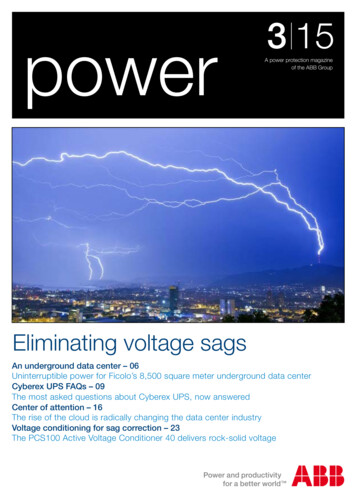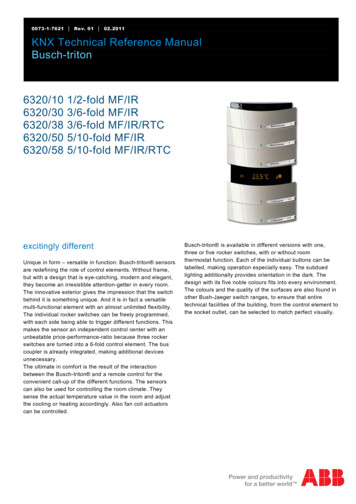
Transcription
0073-1-7621 Rev. 01 02.2011KNX Technical Reference ManualBusch-tritonPos: 2 /Produkthandbuch - DIN-A4/Titelblätter/Titelblatt - Busch-triton @ 11\mod 1279183665269 15.doc @ 82831 @6320/106320/306320/386320/506320/581/2-fold MF/IR3/6-fold MF/IR3/6-fold MF/IR/RTC5/10-fold MF/IR5/10-fold MF/IR/RTCexcitingly differentUnique in form – versatile in function: Busch-triton sensorsare redefining the role of control elements. Without frame,but with a design that is eye-catching, modern and elegant,they become an irresistible attention-getter in every room.The innovative exterior gives the impression that the switchbehind it is something unique. And it is in fact a versatilemulti-functional element with an almost unlimited flexibility.The individual rocker switches can be freely programmed,with each side being able to trigger different functions. Thismakes the sensor an independent control center with anunbeatable price-performance-ratio because three rockerswitches are turned into a 6-fold control element. The buscoupler is already integrated, making additional devicesunnecessary.The ultimate in comfort is the result of the interactionbetween the Busch-triton and a remote control for theconvenient call-up of the different functions. The sensorscan also be used for controlling the room climate. Theysense the actual temperature value in the room and adjustthe cooling or heating accordingly. Also fan coil actuatorscan be controlled. Ende der Liste für Textmarke Cover Busch-triton is available in different versions with one,three or five rocker switches, with or without roomthermostat function. Each of the individual buttons can belabelled, making operation especially easy. The subduedlighting additionally provides orientation in the dark. Thedesign with its five noble colours fits into every environment.The colours and the quality of the surfaces are also found inother Bush-Jaeger switch ranges, to ensure that entiretechnical facilities of the building, from the control element tothe socket outlet, can be selected to match perfect visually.
KNX Technical Reference ManualBusch-tritonPos: 4.1 /Produkthandbuch - DIN-A4/Überschriften/1. Ebene/S - Z/Sicherheitshinweise @ 9\mod 1269243781484 15.doc @ 52309 @ 1Safety instructionsPos: 4.2 /Spezial/Neues Layout 2010/Steuermodule Neues Layout 2010/ Wechsel von ein- auf zweispaltig @ 9\mod 1268898451593 0.doc @ 52140 @Pos: 4.3 /Produkthandbuch - hinweise @ 9\mod 1269245364203 15.doc @ 52365 @Pos: 4.4 /Produkthandbuch - schluss @ 16\mod 1292413036321 15.doc @ 97864 @Work on the 230 V power supply system mustonly be performed by specialist staff.Disconnect the mains power supply prior tomounting and/or disassembly!Failure to observe the installation andoperating instructions may result in fire orother hazards.DisclaimerThe content of this printed material has beenchecked for compliance with hardware andsoftware. However, no liability can be assumedfor any deviations that may still occur. Anynecessary corrections will be implemented infuture versions of this manual.Please advise us of any suggestionsconcerning the manual's improvement you mayhave.Pos: 4.5 /Spezial/Neues Layout 2010/Steuermodule Neues Layout 2010/ Spaltenumbruch @ 9\mod 1268898761421 0.doc @ 52154 @2 0073-1-7621 KNX Technical Reference Manual
Pos: 4.6 /Spezial/Neues Layout 2010/Steuermodule Neues Layout 2010/ Wechsel zwei- auf einspaltig @ 9\mod 1268898591406 0.doc @ 52144 @Pos: 5 /Spezial/Neues Layout 2010/Steuermodule Neues Layout 2010/ Seitenumbruch @ 9\mod 1268898668093 0.doc @ 52149 @Pos: 6.1 /Produkthandbuch - DIN-A4/Überschriften/1. Ebene/S - Z/Technische Daten @ 11\mod 1279185386320 15.doc @ 83019 @ 1Technical dataPos: 6.2 /Produkthandbuch - DIN-A4/Busch-triton/Technische Daten/Technische Daten @ 12\mod 1282831520895 15.doc @ 87813 @AttributeValuePower supplyBus voltage21 to 30 V DC, via bus linecurrent consumption:Type 10 mA ( 2 bus subscribers)ConnectionsKNXBus terminalTemperature sensor systemAccuracy of temperature sensor /- 0.3 K(adjustment possible via parameter)Sensor type: NTCControl and display elementsLCD displayDevices with integrated room thermostat1, 3 or 5 rocker switches with 2 buttons each1, 3 or 5 two-colour LEDsRed or greenBacklit label areasProtectionIP 20, according to DIN EN 60529Protection classIII, acc. to DIN EN 61140Insulation categoryOvervoltage category III, acc. to DIN EN60664-1Contamination degree 2,acc. to DIN EN 60664-1Temperature rangeAmbient conditionsConstruction, housing, designUse-5 C to 45 CStorage-25 C to 55 CTransport-25 C to 70 CMaximum humidity93%, no dew permissibleMaximum air pressureAtmosphere up to 2000 mSurface-mounted with integrated bus couplerWithout additional supply voltageFire characteristics V0RoHs conformity and halogen-freeMountingClicked onto support ringLicenceKNXAccording to EN 50 090-1, -2According to EMC and low-voltage guidelinesPos: 7 /Spezial/Neues Layout 2010/Steuermodule Neues Layout 2010/ Seitenumbruch @ 9\mod 1268898668093 0.doc @ 52149 @KNX Technical Reference Manual 0073-1-7621 3
KNX Technical Reference ManualBusch-tritonPos: 8.1 /Produkthandbuch - DIN-A4/Überschriften/1. Ebene/A - F/Applikationsübersicht @ 14\mod 1286454537749 15.doc @ 92888 @ 1Overview of applicationsPos: 8.2 /Produkthandbuch - DIN-A4/Busch-triton/Applikationsübersicht/Tabelle @ 14\mod 1286373283580 15.doc @ 92443 @ApplicationsFunctionControl elements1/2-fold3/6-foldIR remote control possible Switching, rocker Switching, button Dimming, rocker3/6-fold RTC5/10-fold5/10-fold RTC Dimming, button Roller shutter, rocker Roller shutter, button Value sender, rocker Value sender, rocker Value dimming sensor, rocker Light scene extension unit with memory Step-type switch, rocker Step-type switch, button Short-long operation, button Setting RTC operation mode Switching error protection 13 freely programmable IR channels 8 light scenes Write-on rockers Backlit labelling area Removal protection Freely programmable control panel IR remote control possible Freely programmable additional key functionFeaturesLCD display Heating with additional stage Cooling with additional stage Comfort operation Standby mode Night mode Frost protection Heat protection Fan control Pos: 9 /Spezial/Neues Layout 2010/Steuermodule Neues Layout 2010/ Seitenumbruch @ 9\mod 1268898668093 0.doc @ 52149 @4 0073-1-7621 KNX Technical Reference Manual
Pos: 10.1 /Produkthandbuch - DIN-A4/Überschriften/1. Ebene/M - R/Maßzeichnungen @ 9\mod 1269243888140 15.doc @ 52313 @ 1Dimensional drawingsPos: 10.2 /Spezial/Neues Layout 2010/Steuermodule Neues Layout 2010/ Wechsel von ein- auf zweispaltig @ 9\mod 1268898451593 0.doc @ 52140 @Control element Busch-triton 6320/38Pos: 10.3 /Produkthandbuch - n @ 13\mod 1284973860036 15.doc @ 90164 @Control element Busch-triton 6320/108490Control element Busch-triton 6320/30Control element Busch-triton 6320/50 and 6320/58Pos: 10.4 /Spezial/Neues Layout 2010/Steuermodule Neues Layout 2010/ Wechsel zwei- auf einspaltig @ 9\mod 1268898591406 0.doc @ 52144 @Pos: 11 /Spezial/Neues Layout 2010/Steuermodule Neues Layout 2010/ Seitenumbruch @ 9\mod 1268898668093 0.doc @ 52149 @KNX Technical Reference Manual 0073-1-7621 5
KNX Technical Reference ManualBusch-tritonPos: 12.1 /Produkthandbuch - DIN-A4/Überschriften/1. Ebene/A - F/Einfache Montage @ 9\mod 1269243901843 15.doc @ 52338 @ 1Easy to mountPos: 12.2 /Produkthandbuch - DIN-A4/Busch-triton/Einfache Montage/Einfache Montage - Text @ 12\mod 1283176252903 15.doc @ 88128 @NoteFor the horizontal installation of two Busch-triton button sensors, it is recommended to keep a distance of 112 mm (bymeans of 2 flush-mounted box spacers, e.g. 2 x Kaiser spacing collars 91).Screwed connection of the Busch-triton cover with the support ringInstallation of label areasFurther information is contained in the "Installation and Operating Instructions".Pos: 13 /Spezial/Neues Layout 2010/Steuermodule Neues Layout 2010/ Seitenumbruch @ 9\mod 1268898668093 0.doc @ 52149 @6 0073-1-7621 KNX Technical Reference Manual
Pos: 14.1 /Produkthandbuch - DIN-A4/Überschriften/1. Ebene/M - R/Raumtemperaturregler @ 13\mod 1286268674432 15.doc @ 91479 @ 1Room thermostatPos: 14.2 /Produkthandbuch - DIN-A4/Überschriften/2. Ebene/P - R/Raumtemperaturregler-Display @ 13\mod 1286269387786 15.doc @ 91504 @ 2Room thermostat with displayPos: 14.3 /Produkthandbuch - DIN-A4/Überschriften/3. Ebene/Standardansicht @ 13\mod 1286269449786 15.doc @ 91512 @ 3Standard viewPos: 14.4 /Spezial/Neues Layout 2010/Steuermodule Neues Layout 2010/ Wechsel von ein- auf zweispaltig @ 9\mod 1268898451593 0.doc @ 52140 @Pos: 14.5 /Produkthandbuch - nsicht @ 13\mod 1286269136131 15.doc @ 91487 @Operating stateOperating modeActual or setpoint temperatureThe display of the room thermostat shows either the currentroom temperature or the setpoint for the temperature,depending on the parameterization.The current operating state is shown in the left area of thedisplay and the current operating mode in the right area.Pos: 14.6 /Spezial/Neues Layout 2010/Steuermodule Neues Layout 2010/ Wechsel zwei- auf einspaltig @ 9\mod 1268898591406 0.doc @ 52144 @Pos: 14.7 /Produkthandbuch - DIN-A4/Überschriften/3. Ebene/Sollwerte @ 13\mod 1286269492130 15.doc @ 91520 @ 3Set valuesPos: 14.8 /Spezial/Neues Layout 2010/Steuermodule Neues Layout 2010/ Wechsel von ein- auf zweispaltig @ 9\mod 1268898451593 0.doc @ 52140 @Pos: 14.9 /Produkthandbuch - DIN-A4/Busch-triton/Raumtemperaturregler/Sollwerte @ 13\mod 1286269283224 15.doc @ 91495 @Heating setpointCooling setpoint{ Temperature z Next setpoint{ Temperature z Previous setpoint{ Comfort/Standbyz On/Off{ FanCoil-Steps{ Short pressz Long pressIn the setting level, which is accessed by pressing theadditional key once, the setpoints for heating and/or coolingcan be adjusted.The corresponding setpoints are located to the right of eachrespective symbol for heating or cooling.The value brightly highlighted can be changed.The adjustment is made with the upper rocker of the controlelement. A short press of the left side lowers the setpoint, ashort press of the right side raises the setpoint. With a longpress of the button the selection jumps to the next setpoint.This one can now also be adjusted with a short press of thebutton.After an adjustable time, the display returns to the standardview.Pos: 14.10 /Spezial/Neues Layout 2010/Steuermodule Neues Layout 2010/ Wechsel zwei- auf einspaltig @ 9\mod 1268898591406 0.doc @ 52144 @Pos: 14.11 /Spezial/Neues Layout 2010/Steuermodule Neues Layout 2010/ Seitenumbruch @ 9\mod 1268898668093 0.doc @ 52149 @KNX Technical Reference Manual 0073-1-7621 7
KNX Technical Reference ManualBusch-tritonPos: 14.12 /Produkthandbuch - DIN-A4/Überschriften/2. Ebene/A - F/Betriebsarten @ 13\mod 1286276050737 15.doc @ 91535 @ 2Operating modesPos: 14.13 /Spezial/Neues Layout 2010/Steuermodule Neues Layout 2010/ Wechsel von ein- auf zweispaltig @ 9\mod 1268898451593 0.doc @ 52140 @Pos: 14.14 /Produkthandbuch - rten zwei @ 13\mod 1286273939022 15.doc @ 91528 @Standby: Standby mode lowers theNight setback: The temperature can betemperature below the value of comfortreduced during the night. This saves energymode. This saves energy and does not cooland makes the night's rest comfortable. Thedown the room even during an extendedheating starts again automatically the nextabsence.morning to reach a comfortable temperaturefor rising.Comfort: Comfort mode regulates theFrost protection: If parameterized, frosttemperature to suit the occupants whileprotection will ensure that the temperaturepresent. It can be called up time-controlleddoes not drop below the desired value. It isor via a telegram.the lowest setpoint.Dew point: If an appropriate telegram isreceived from a dew point sensor, the roomHeat protection: If parameterized, heatthermostat will display the correspondingprotection will ensure that the temperaturesymbol and cease cooling and merelydoes not exceed the desired value. It is theprotect against the heat.highest setpoint.Alarm: The alarm can be freelyparameterized. For example, it can occurwhen an external temperature sensor noCondensate: The operation of a fan coil maylonger sends values.cause condensate water, which is collectedin a container. If the fan coil sends out atelegram when the container is full, thesymbol for condensate mode is displayed.The room thermostat immediately switchesinto heat protection mode.Pos: 14.15 /Spezial/Neues Layout 2010/Steuermodule Neues Layout 2010/ Wechsel zwei- auf einspaltig @ 9\mod 1268898591406 0.doc @ 52144 @Pos: 14.16 /Spezial/Neues Layout 2010/Steuermodule Neues Layout 2010/ Seitenumbruch @ 9\mod 1268898668093 0.doc @ 52149 @8 0073-1-7621 KNX Technical Reference Manual
Pos: 14.17 /Produkthandbuch - DIN-A4/Überschriften/2. Ebene/A - F/Bedienelemente @ 13\mod 1286277412052 15.doc @ 91551 @ 2Control elementsPos: 14.18 /Spezial/Neues Layout 2010/Steuermodule Neues Layout 2010/ Wechsel von ein- auf zweispaltig @ 9\mod 1268898451593 0.doc @ 52140 @Pos: 14.19 /Produkthandbuch - ment 1/2 @ 13\mod 1286277092802 15.doc @ 91544 @ 333331/2-fold control element with backlit label area and IRreception5/10-fold control element with backlit label area and IRreceptionThe control elements have "large" freely programmableoperating surfaces. They can be occupied with both rockeras well as button oriented applications.3/6-fold control element with backlit label area,integrated room thermostat and IR receptionVia the additional key there is the option of saving lightingscenes or controlling the backlighting of the label area.5/10-fold control element with backlit label area,integrated room thermostat and IR receptionThe control elements have two operating levels. On the firstlevel the on-site operations are triggered, the additional keyis used to access the second operating level with which theheating control can be operated.3/6-fold control element with backlit label area and IRreceptionAlternative to the second operating level, also the operatingsurfaces can be used to control the the functions of the roomthermostat.Pos: 14.20 /Spezial/Neues Layout 2010/Steuermodule Neues Layout 2010/ Wechsel zwei- auf einspaltig @ 9\mod 1268898591406 0.doc @ 52144 @Via the additional key there is the option of executing all thefunctions of a button or, on units with a room thermostat, toaccess the setting level.Pos: 14.21 /Spezial/Neues Layout 2010/Steuermodule Neues Layout 2010/ Seitenumbruch @ 9\mod 1268898668093 0.doc @ 52149 @KNX Technical Reference Manual 0073-1-7621 9
KNX Technical Reference ManualBusch-tritonPos: 14.22 /Produkthandbuch - DIN-A4/Überschriften/3. Ebene/Verfügbare Farben @ 14\mod 1286352522378 15.doc @ 91714 @ 3Available coloursPos: 14.23 /Spezial/Neues Layout 2010/Steuermodule Neues Layout 2010/ Wechsel von ein- auf zweispaltig @ 9\mod 1268898451593 0.doc @ 52140 @Pos: 14.24 /Produkthandbuch - DIN-A4/Busch-triton/Raumtemperaturregler/Farben @ 14\mod 1286282747698 15.doc @ 91616 @PlatinumAluminium silverPalladiumStudio whitePos: 14.25 /Spezial/Neues Layout 2010/Steuermodule Neues Layout 2010/ Wechsel zwei- auf einspaltig @ 9\mod 1268898591406 0.doc @ 52144 @ChampagnePos: 15 /Spezial/Neues Layout 2010/Steuermodule Neues Layout 2010/ Seitenumbruch @ 9\mod 1268898668093 0.doc @ 52149 @10 0073-1-7621 KNX Technical Reference Manual
Pos: 16.1 /Produkthandbuch - DIN-A4/Überschriften/1. Ebene/M - R/Planerunterstützung RTR @ 13\mod 1286265494848 15.doc @ 91464 @ 1Planner support for RTCPos: 16.2 /Produkthandbuch - DIN-A4/Busch-triton/Bedienung/Betriebsarten @ 13\mod 1284551640044 15.doc @ 89965 @ 2Operating modesThe room thermostat has four operating modes: Frost protection mode (for heating): The room temperature control is inactive; heating is only carried out when thetemperature in the room drops to the point where the heating system could sustain damage through freezing.Heat protection mode (for cooling): The room temperature control is inactive; cooling is only carried out when thetemperature has risen to the point where the heat in the room becomes unbearable. Comfort mode (for heating and cooling): The setpoint for the room temperature is set to a value that makes thetemperature of the room comfortable during "normal use". Standby mode (for heating): The room temperature is reduced to the point where heating costs are saved (e.g. duringtemporary absence), but can be quickly raised to comfort temperature again.Standby mode (for cooling): The room temperature is only raised to the point where energy costs are saved (e.g. duringtemporary absence), but can be quickly increased to comfort temperature again. Night mode (for heating and cooling): Rooms are not used for longer periods during the night hours; the room temperatureis set a comfortable night-time value and can be quickly raised again to the comfort setpoint in the morning.A switchover between these operating modes can take place either by means of a switching telegram (parameter "Operatingmode switchover": "1 bit (3x)") or with 1-byte value telegrams (parameter "Operating mode switchover": "1 byte (2x)").Pos: 16.3 /Produkthandbuch - tung 1 Bit @ 13\mod 1284559347241 15.doc @ 89973 @ 3Operating mode switchover, 1 bitFrost/heat protection has the highest priority; i.e., switchover to a different mode cannot take place in this case. Thefrost/heat protection must first be deactivated; by closing an open window, for example. Night mode has the next highestpriority, followed by comfort mode. If none of these three operating modes are active, the room thermostat is in standbymode.Pos: 16.4 /Produkthandbuch - tung 1 Byte @ 13\mod 1284559643038 15.doc @ 89981 @ 3Operating mode switchover, 1 byteTwo 1-byte communication objects are made available with operation mode switchover via 1 byte.The two 1-byte communication objects have different behaviours for receipt of telegram. One object evaluates receivedtelegrams as "normal". This means, for example, if a comfort telegram is received, the room thermostat switches to comfortmode. If a night telegram is received, the room thermostat switches to night mode. This object is controlled, for example, bytime switches.The second object ("Operating mode switchover OMO") can "overwrite" the first. This means, for example, if a frost/heatprotection telegram is received, the room thermostat switches to frost or heat protection mode. If frost or heat protection isreset after receipt of a new telegram, the room thermostat activates the mode that is pending on the "normal" object. As aresult, it is capable of memorising operating modes. This object is controlled, for example, by binary inputs that recordinformation from window contacts.The following conditions apply for both 1-byte communication objects:0 Auto (only for "Operating mode switchover OMO“)1 Comfort2 Standby3 Night4 Frost/Heat protection5 – 255 not allowedPos: 16.5 /Produkthandbuch - DIN-A4/Busch-triton/Bedienung/Temperaturmessung @ 13\mod 1284626154763 15.doc @ 89994 @ 2Temperature measurementThe room thermostat with display can record the temperature via an internal sensor. Additionally, values can be receivedfrom an external sensor or an external temperature sensor via communication objects. The incoming values can bemonitored and, if necessary, adjusted. The functions are explained in greater detail in the following.Pos: 16.6 /Produkthandbuch - DIN-A4/Busch-triton/Bedienung/Interne Temperaturerfassung @ 13\mod 1284626329778 15.doc @ 90002 @ 3KNX Technical Reference Manual 0073-1-7621 11
KNX Technical Reference ManualBusch-tritonInternal temperature sensorThe device has an integrated temperature sensor. The measured value enters the control as actual value. The value canalso be shown on the display.In addition, the measured temperature can be transferred to the bus via the 2-byte communication object "Send actual value- temperature sensor", to be shown on the display, for example. Sending takes place in dependence of parameters "Sendactual value for change greater than" and "Send actual value cyclically". By default, both parameters are deactivated. Thismeans that at least one setting must be activated if the actual temperature is to be sent.The setting "Send actual value for change greater than" has the advantage of being able to transmit the smallest change inthe measured temperature, adjustable from 0.1 k to 1.0 K, to the bus. The disadvantage is, for example, that at a setting of0.1 K and a lot of room thermostats within an installation, the load on the bus increases.The parameter "Send actual value cyclically" has the advantage that the current actual value is sent out continuously, evenwhen the measured value does not change. The disadvantage is that rapid changes may not be registered because thecycle time selected is too large. It should also not be small because of the extreme load the bus is subjected to.Pos: 16.7 /Produkthandbuch - DIN-A4/Busch-triton/Bedienung/Externe Temperaturerfassung @ 13\mod 1284635472980 15.doc @ 90010 @ 3External temperature sensorIn open-plan offices it can be difficult to control the temperature with only a single thermostat. That is why it would beadvantageous to divide the room into zones with an additional room thermostat.To integrate the temperature value of the additional temperature sensor into the temperature control, the parameter "Roomtemperature measurement" must be set on "Internal and external". The the temperature measured inside and outside canthen be additionally weighted. The setting for weighting depend on the local circumstances. If the room thermostat and theadditional measuring sensor are positioned equal distances from the heater, in the case of panel heaters, a 50% / 50%setting should provide good control results.Pos: 16.8 /Produkthandbuch - DIN-A4/Busch-triton/Bedienung/Überwachung Temperaturmessung @ 13\mod 1284635867620 15.doc @ 90018 @ 3MonitoringThe "Temperature measurement monitoring" parameter specifies whether the external temperature sensor and the outsidetemperature are to be monitored. This means that the room thermostat has to receive at least one telegram with the currenttemperature on the associated communication object within an adjustable time ("Monitoring time of external temperature"and "Monitoring time of outside temperature").If no telegram is received during monitoring time, the room thermostat assumes that the measuring sensor for the outsidetemperature or external temperature is defective or no longer connected to the bus.The room thermostat will then terminate its control and send a predefined control value ("Control value during temperaturemeasurement error") so that the room to be controlled does not overheat or cool down. This control value is sent out until theroom thermostat again receives a temperature telegram via the bus and reactivates the control.Pos: 16.9 /Produkthandbuch - DIN-A4/Busch-triton/Bedienung/Abgleich Temperaturmessung @ 13\mod 1284636694181 15.doc @ 90026 @ 3AdjustmentIf the measured temperature is distorted, such as by the inherent heat of the bus coupler, an "Offset room temperaturemeasurement" can be set.If additional external temperature recording has been activated and the measured value becomes distorted through theinfluence of cold or heat, here, too, an offset can be entered.Pos: 16.10 /Spezial/Neues Layout 2010/Steuermodule Neues Layout 2010/ Seitenumbruch @ 9\mod 1268898668093 0.doc @ 52149 @12 0073-1-7621 KNX Technical Reference Manual
Pos: 16.11 /Produkthandbuch - DIN-A4/Busch-triton/Bedienung/Regler @ 13\mod 1284636897353 15.doc @ 90034 @ 2ControllerThe room thermostat can be used exclusively for heating, exclusively for cooling or for heating and cooling.If the room thermostat is to heat or cool, the switchover from heating to cooling or cooling to heating can occur automaticallyby means of the room thermostat. The controller detects automatically whether a control value for heating or cooling is to besent out. If the automatic switchover is not required, the switchover between heating and cooling can take place by means ofan external, central control via the 1-bit object "Switchover heating/cooling". In this setup, the heat and cooling icons arecontinuously displayed in the respective mode. The object is enabled via parameter "Switchover between heating/cooling".The control value for heating and/or cooling can be sent out on a common communication object "Heating/cooling controlvalue" or on two individual communication objects "Heating control value" and "Cooling control value". If a common object isused, it may be necessary to inform the actuator whether the control value is for heating or cooling. For this, a 1-bitcommunication object "Switchover heating/cooling" can be enabled via parameter "Switchover between heating and cooling"with setting "Automatic and sending". For activation of heating operating mode a "1" is sent to the bus, for activation ofcooling mode a "0".A common communication object for heating and cooling is required to activate two two-pipe systems, i.e., the same pipelineis used for heating and cooling. Two single communication objects are used for four-pipe systems. Heating and cooling eachhave their own pipeline system.Parameter "Number of output channels" specifies whether an object ("1 channel (two-pipe system) for heating and cooling")or two objects ("2 channels (four-pipe system) for heating and cooling") are to be displayed.Separate control types can be configured each for heating and cooling. One of the following control types can be selected: 2-point PWM Continuous Fan coilThe individual control types are described in greater detail in the following.Pos: 16.12 /Produkthandbuch - DIN-A4/Busch-triton/Bedienung/Zweipunktregler @ 13\mod 1284639958501 15.doc @ 90042 @ 32-point controllerA 2-point controller has two output states that alternate in dependence of the actual value. If the actual value is above theparameterised setpoint, control value "0" is sent on the bus. If the actual value is below the parameterised setpoint, controlvalue "1" is sent.A 2-point controller should be used when the control value is to alternate only between the two states ON and OFF, such asan electrothermal valve that is connected to a switch actuator, for example. A 2-point controller can quickly correct controlvariations in case of large changes in the control variable, but never comes to rest.To avoid rapid oscillations of the output states, the 2-point controllers always have a built-in hysteresis that varies aroundthe setpoint. The hysteresis can have different size parameters. For example, if the setpoint during heating mode is 21 Cand the hysteresis is 1.0 K, the controller switches on when the value falls below 20.5 C and switches off again whenexceeding 21.5 C. The "Hyteresis" parameter to be set, on the one hand responds to how quickly the heating can heat theroom or how quickly the air-conditioning cools the room, and on the other hand to the desired temperature of the people inthe room. The hysteresis should not be set too small, otherwise the switching actuator will constantly open and close. Thehysteresis should also not be set too large, otherwise the temperature fluctuations in the room will be too large.Pos: 16.13 /Spezial/Neues Layout 2010/Steuermodule Neues Layout 2010/ Seitenumbruch @ 9\mod 1268898668093 0.doc @ 52149 @KNX Technical Reference Manual 0073-1-7621 13
KNX Technical Reference ManualBusch-tritonPos: 16.14 /Produkthandbuch - DIN-A4/Busch-triton/Bedienung/Stetigregler @ 13\mod 1284706827607 15.doc @ 90054 @ 3Continuous controllerA continuous controller has a continuously changing control value which can accept values between 0 and 100%. For theKNX this control value signal is converted to a 1-byte value, which means that control value 0% corresponds to value "0" andcontrol value 100% to value "255".Continuous controllers with a 1-byte control value, for example, can be used to activate electromotive actuating drives. Theytranslate the value received directly into the valve position via an installed motor. This results in optimum control.The 1-byte control value of a continuous controller can also be sent to KNX heating actuators which convert the 1-byte signalinto a PWM size. This allows electrothermal valves to be activated. Here it is practical to limit the dynamic range sinceelectrothermal valves require time to open and close. This takes place via parameters "Minimum control value" or "Maximumcontrol value". If, for example, a maximum control value of 80% is specified, the control will always automatically send thevalue 255 when the control value of 204 has been exceeded.To protect the bus from unnecessary loads the change of the control value that is permitted
future versions of this manual. concerning the manual's improvement you may have. . KNX Technical Reference Manual Easy to mount Pos: 12.2 /Produkthandbuch - DIN-A4/Busch-triton/Einfache Montage/Einfache Montage - Text @ 12\mod_1283176252903_15.doc @ 88128 @ Note
